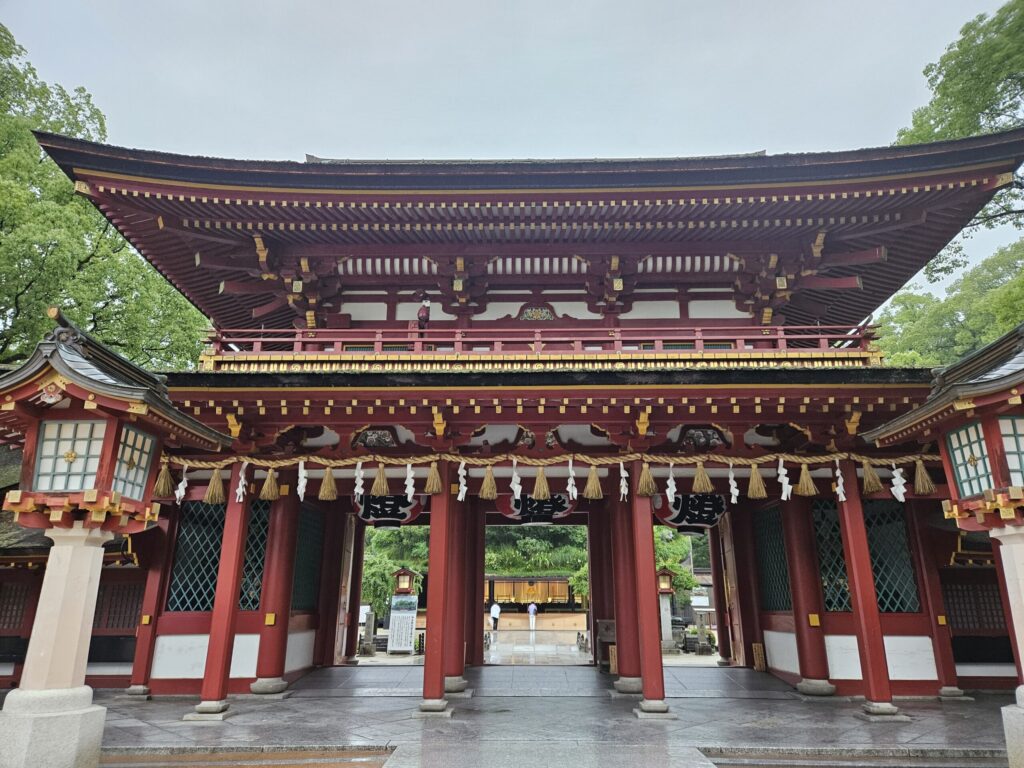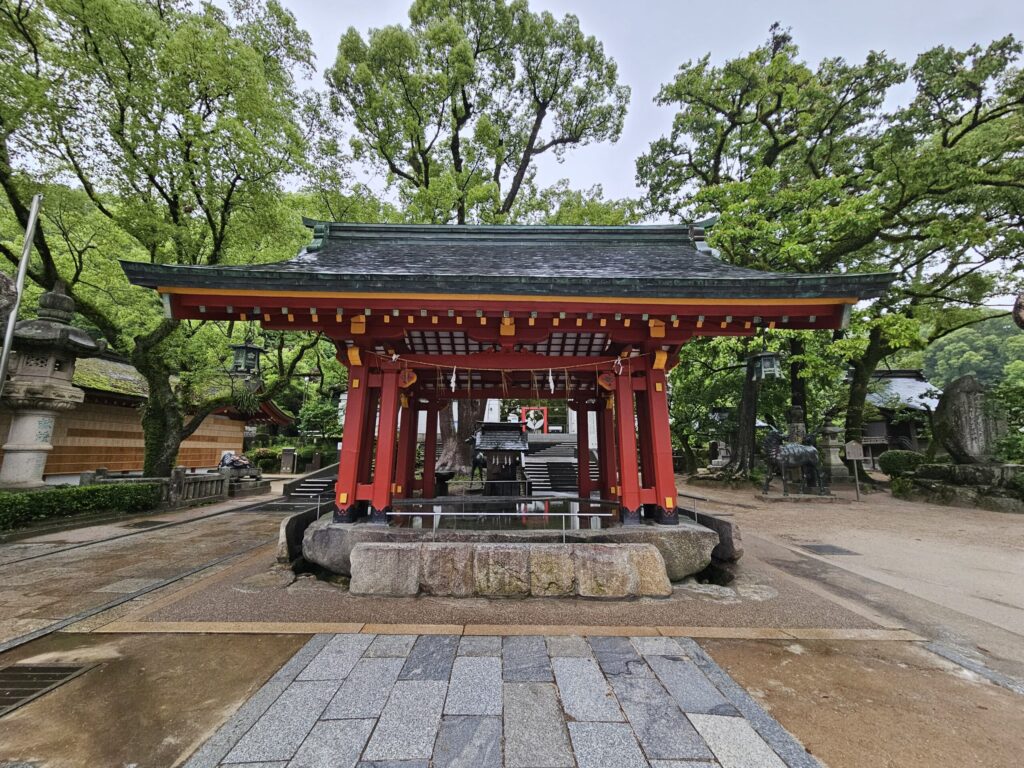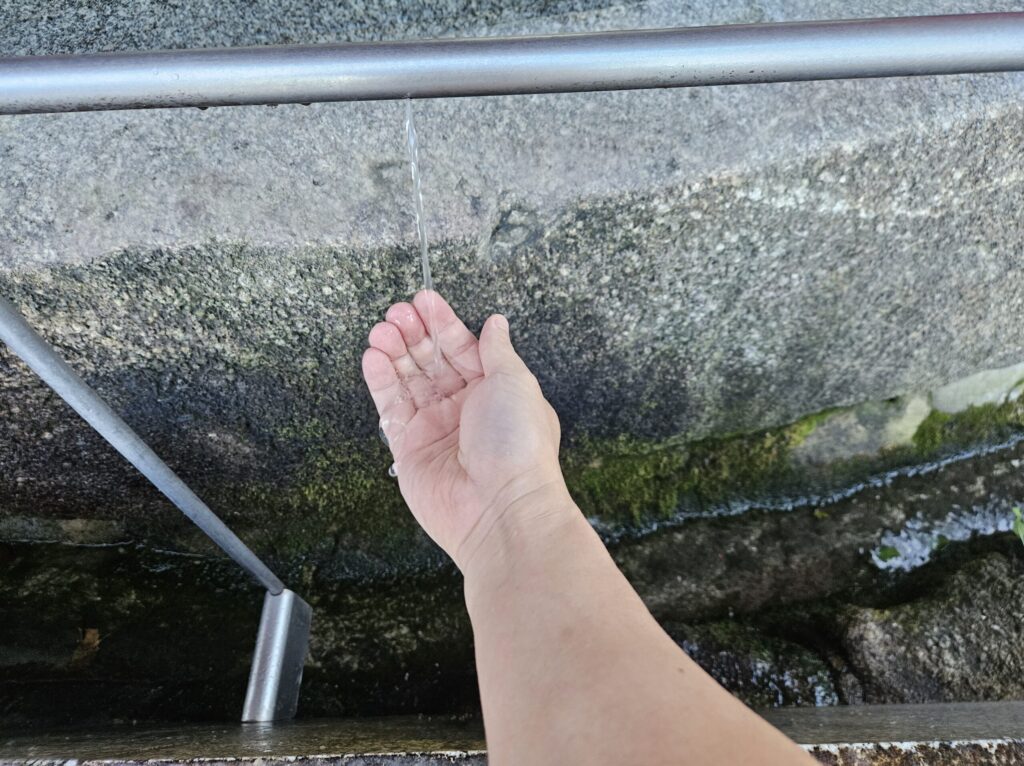- Why Shrine Etiquette Matters
- Step 1: Don’t Walk in the Center of the Path
- Step 2: Bow Before Passing Through the Torii Gate or Romon Gate (and When You Leave)
- Step 3: Purify Yourself at the Temizuya (Water Basin)
- Step 4: Offer a Coin (Saisen)
- Step 5: Ring the Bell (or Take a Quiet Moment Instead)
- Step 6: Two Bows, Two Claps, One Bow
- Step 7: Make Your Wish Silently
- tep 8: Bow Again Before Leaving
- Final Thoughts
Why Shrine Etiquette Matters
When you visit a Japanese shrine, you’ll notice there are certain manners or “etiquette” to follow.
But don’t worry — these aren’t strict religious rules.
They’re more like signs of respect for the place you’re visiting.
In Japan, shrines are believed to be the homes of the gods (kami).
So when you enter one, it’s like stepping into someone’s house —
a sacred home where the deity lives.
Think of it this way:
When you visit a friend’s house, you probably say hello to their parents,
and act politely, right?
Visiting a shrine is very similar — you’re just showing respect to the “host” of the house, the god.
These manners are not meant to be strict rules;
they’re simply a way of saying,
“I’m grateful to be here, and I respect this sacred place.”
So even if you make a small mistake, that’s totally fine.
What matters most is your heart — sincerity, respect, and gratitude.
If you keep that in mind, the gods will surely welcome you warmly. 🌸
Step 1: Don’t Walk in the Center of the Path
When you enter a shrine, you’ll see a straight path leading to the main hall —
this is called the sando (approach path).

In Shinto tradition, the center of this path is considered the way of the gods.
That’s why visitors, as guests, walk along the sides instead of the middle.
You can walk on either side, but in Japan people usually keep to the left,
so staying on the left side makes it easier to pass others politely.
Imagine the center as a red carpet reserved for the deity —
walking along the edge is a way to show respect for the sacred “host” of this place.
As you stroll through the shrine grounds,
think of yourself as an invited guest in a peaceful, spiritual home.
Walk slowly, breathe in the calm air, and you might start to feel
the special, sacred atmosphere of the shrine. 🌸
Step 2: Bow Before Passing Through the Torii Gate or Romon Gate (and When You Leave)
At the entrance of every shrine, you’ll find a torii gate —
a symbolic gateway that separates the human world from the sacred world of the gods.
Passing through it means stepping into the home of the deity, a place of purity and peace.
While many shrines in Japan have bright red torii gates,
the ones at Dazaifu Tenmangu are different —
they’re made of stone and left in their natural gray color.
This gives the shrine a calm and elegant atmosphere, perfectly matching its serene surroundings.
(You’ll see this clearly in the photo below!)

Before walking through the torii, take a brief moment to stop and bow gently toward the main hall.
This small bow expresses, “Excuse me for entering your sacred home.”
A bit further inside Dazaifu Tenmangu, you’ll come across another important gate called the Romon.

This beautiful two-story gate also marks a sacred boundary.
Just like before, take a moment to bow before you pass through.
When you finish your visit and walk back toward the exit,
turn around and bow once more before passing under the Romon or torii again.
This final bow is your way of saying,
“Thank you for having me.”
Think of it like visiting a friend’s house —
you say hello when you arrive, and thank them when you leave.
Showing that same polite attitude at a shrine is the best way to show respect to the gods.
Such a simple gesture, yet it brings a feeling of calm and connection —
as if the shrine itself is smiling back at you. 🌸
Step 3: Purify Yourself at the Temizuya (Water Basin)
After passing through the torii gate, you’ll find a small water pavilion called the temizuya (or chozuya) just before the Romon Gate.
This is where visitors cleanse their hands and mouth before approaching the main hall.

In Shinto belief, a shrine is considered the home of the gods,
so it’s only polite to “wash away” the impurities of daily life before meeting them.
Think of it like taking a refreshing shower before meeting someone special —
it’s a small act of respect that helps you enter the sacred space with a clear heart.
At Dazaifu Tenmangu’s Temizuya
You might notice something different here — there are no ladles at Dazaifu Tenmangu’s water basin.
Since the COVID-19 pandemic, many shrines have removed the shared ladles to prevent the spread of infection.
Instead, clean water flows continuously,
so you can still perform the purification ritual easily by following these steps:
1️⃣ Wash your left hand.
2️⃣ Wash your right hand.
3️⃣ Scoop a little water into your left hand and rinse your mouth lightly.
(Don’t swallow — just spit gently to the side.)


That’s it!
Even without a ladle, this flowing water lets you cleanse yourself just as meaningfully.
What matters most is the feeling of purity and respect you bring to the ritual.
If You Visit a Shrine with Ladles
At many other shrines in Japan, ladles (hishaku) are still provided.
Here’s the traditional way to use one:
1️⃣ Hold the ladle in your right hand and pour water over your left hand.
2️⃣ Switch hands and pour water over your right hand.
3️⃣ Pour some water into your left hand and rinse your mouth lightly.
4️⃣ Rinse your left hand once more.
5️⃣ Finally, tilt the ladle upright so that the remaining water flows down the handle to cleanse it,
then place it back gently for the next person.
Both methods serve the same purpose — to prepare yourself, body and mind,
before stepping closer to the deity.
Take your time, listen to the gentle sound of water, and let your heart feel calm.
At Dazaifu Tenmangu, the temizuya is especially beautiful —
sometimes decorated with seasonal flowers floating on the water,
making it one of the most photogenic spots in the shrine. 📸
But before you take your photo, take a quiet moment to purify yourself first.
It’s a simple gesture that makes your visit feel truly special.
Step 4: Offer a Coin (Saisen)
After purifying yourself at the temizuya, head toward the main hall.
The first thing you’ll do here is offer a coin, called saisen (賽銭).
The saisen is like a small offering to the gods —
a way to show your respect and gratitude before making your wish.
Simply bow slightly in front of the offertory box,
and gently place your coin inside without throwing it.
It’s not about the amount — it’s the heart behind the act that matters.
Lucky and Unlucky Coin Amounts in Japan
- ✅ 5 yen (go-en): Brings good connection — “Go-en” sounds like the word en, meaning “relationship” or “bond.”
- ✅ 45 yen (10 yen × 4 + 5 yen): Means “shi-juu go-en,” or “always connected.”
- 🚫 10 yen: Avoid this one! It can be read as “too distant” (toh-en), which sounds like “far away connection.”

It might sound like wordplay, but in Japan, words are believed to carry spiritual power (kotodama).
So even these small puns reflect a heartfelt wish for good relationships and blessings from the gods.
At some shrines, you may also see bells or ropes above the offertory box.
Visitors ring them gently to let the gods know they’ve arrived.
However, Dazaifu Tenmangu doesn’t have a bell,
so after offering your coin, you can simply move on to the next step — the prayer itself.
When offering your saisen, think of it not just as “giving money,”
but as a small, beautiful moment to express gratitude and sincerity.
That feeling is what truly reaches the gods —
and it’s what makes your visit to Dazaifu Tenmangu feel truly special. 🌸
Step 5: Ring the Bell (or Take a Quiet Moment Instead)
At many shrines in Japan, after offering a coin,
you’ll see a large bell or a rope with small bells hanging above the offertory box.
Visitors gently shake the rope to ring the bell before praying.
This sound has a special meaning —
it’s a polite way of saying,
“Excuse me, dear gods, I’m here to pray now.”
The clear tone of the bell is also believed to purify the air and drive away negative energy,
creating a sacred space for your prayer.
At Dazaifu Tenmangu
You might notice something different here —
there’s no bell or rope at Dazaifu Tenmangu Shrine.
That’s perfectly normal!
Each shrine in Japan has its own style and traditions.
At Dazaifu, instead of ringing a bell,
take a quiet moment to center yourself before you begin your prayer.
You can close your eyes, take a slow breath,
and calm your heart — that alone is a beautiful way to greet the gods.
If You Visit a Shrine That Has a Bell
1️⃣ Bow slightly in front of the offertory box.
2️⃣ Gently ring the bell to let the gods know you’ve arrived.
3️⃣ Then straighten your posture and begin your prayer calmly.
Even without the sound of a bell,
the atmosphere at Dazaifu Tenmangu is deeply peaceful.
You can hear the rustle of trees, the footsteps of visitors,
and the soft hum of devotion in the air.
Let that quietness be your “bell,”
and step into the next part of the prayer —
two bows, two claps, and one final bow. 🌸
Step 6: Two Bows, Two Claps, One Bow
Now comes the heart of Shinto-style prayer — the simple yet beautiful ritual called “two bows, two claps, one bow.”
It’s the traditional way to show respect, gratitude, and sincerity to the gods at a shrine.

How to Do It
1️⃣ Bow Twice
Stand straight, then bend deeply at the waist — about 45 degrees — and bow two times.
The first bow is a sign of respect for the gods.
The second bow expresses your gratitude for being able to visit and pray.
2️⃣ Clap Twice
Raise your hands in front of your chest and clap twice.
The sound of your hands coming together is believed to get the gods’ attention —
it’s a way of saying, “I’m here, and I’m speaking to you with my heart.”
After clapping, keep your hands together and make your wish silently.
3️⃣ Bow Once More
Finish with one final, deep bow.
This last bow is your way of saying,
> “Thank you for listening.”
What to Pray For at Dazaifu Tenmangu
The deity enshrined here, Sugawara no Michizane,
is known as the god of learning, wisdom, and effort.
That’s why many visitors pray for things like:
- success in exams or studies,
- improving their skills,
- or staying motivated to keep learning.
But before making your wish, it’s lovely to start with gratitude —
for your health, your safe journey, or simply being here today.
A thankful heart is said to make prayers reach the gods more clearly. 🌸
Tips for a Graceful Prayer
- Take your time — move slowly and calmly when you bow.
- You don’t need to clap loudly; a gentle sound is enough.
- If you’re visiting with someone, try to keep your movements in sync — it looks beautiful and respectful.
The front of Dazaifu Tenmangu’s main hall feels peaceful and sacred.
When you bow there, surrounded by the quiet and the soft scent of incense,
you may feel a deep sense of calm —
as if the gods themselves are gently watching over you!
Step 7: Make Your Wish Silently
After completing the “two bows, two claps, one bow,”
keep your hands together and make your wish silently in your heart.
There’s no need to say anything out loud —
the gods can hear the words that come from your heart. 💫
What Should You Wish For?
At Dazaifu Tenmangu, the deity enshrined here is Sugawara no Michizane,
who is widely known as the god of learning and wisdom in Japan.
That’s why many visitors come here to pray for things like:
- success in exams or school,
- the ability to learn new skills,
- or the strength to keep working hard.
But of course, your prayer doesn’t have to be about studying.
You can also wish for your family’s health,
happiness for someone you care about,
or simply peace in your heart.
Tips for a Heartfelt Prayer
- It doesn’t have to be long — a few sincere words are enough.
- Try adding a little gratitude to your prayer, like: “Thank you for letting me come here today.”
Instead of only asking for something, expressing thanks first makes your wish feel more genuine. - Don’t rush — there’s no time limit, no “shooting star” moment.
Just breathe slowly and share your feelings with the gods.
Dazaifu Tenmangu is a place filled with peaceful energy and warm hopes.
Students, families, and travelers from all over Japan come here to pray.
When you close your eyes and make your wish,
you might feel that quiet connection —
as if your heart is gently reaching the gods. 🌸
tep 8: Bow Again Before Leaving
Once you finish your prayer, don’t rush to leave just yet.
Before passing back through the Romon Gate or the torii,
take a moment to turn around and bow once more toward the main hall.
When you first entered the shrine, you bowed to say,
“Excuse me for entering your sacred place.”
Now, as you leave, this final bow means,
“Thank you for listening to my prayer.”
It’s a small gesture, but it carries deep meaning —
a quiet way to express your gratitude before returning to the everyday world.
How to Leave Dazaifu Tenmangu Gracefully
At Dazaifu Tenmangu, it’s customary to bow gently in front of the main hall after you’ve finished praying.
Then, before passing through the Romon Gate,
turn toward the main hall again and bow once more.
As you walk down the approach and reach the last torii gate,
turn back one final time, face the shrine, and offer a small, respectful bow.
It’s such a simple act, but it helps you mark the end of your visit —
a calm, thoughtful moment to close your prayer and leave with a peaceful heart.
Final Thoughts
And that’s the end of your visit to Dazaifu Tenmangu Shrine.
I hope this guide helped you understand not just how to pray,
but also why each gesture and action carries meaning.
Shinto etiquette isn’t about following strict rules —
it’s about showing respect, gratitude, and kindness in a simple, mindful way.
Even small actions — bowing, washing your hands, offering a coin —
become a way to connect your heart with something greater.
It might have been a bit long, but I wanted to explain everything carefully
so you could experience this beautiful tradition with confidence.
Thank you so much for reading all the way to the end. 🌿
When you visit Dazaifu Tenmangu,
take your time, move gently, and feel the calm atmosphere around you.
The shrine isn’t just a place to make a wish —
it’s a place to breathe, to reflect,
and to quietly appreciate the moment you’re in. 🌸
Wishing you a smooth journey and a memorable visit to Dazaifu!
– Sachi 🌸




コメント